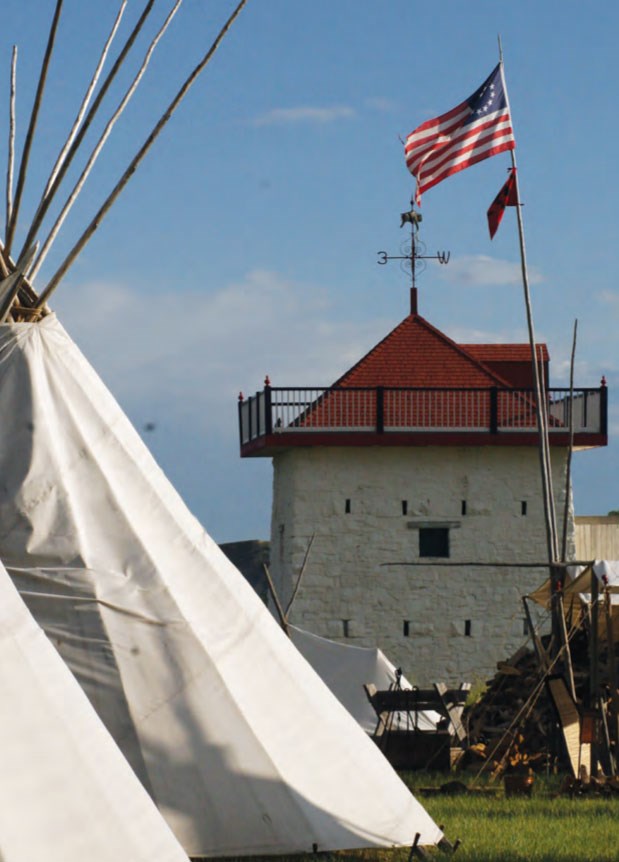Last updated: June 18, 2024
Article
NPS Geodiversity Atlas—Fort Union Trading Post National Historic Site, North Dakota and Montana
Geodiversity refers to the full variety of natural geologic (rocks, minerals, sediments, fossils, landforms, and physical processes) and soil resources and processes that occur in the park. A product of the Geologic Resources Inventory, the NPS Geodiversity Atlas delivers information in support of education, Geoconservation, and integrated management of living (biotic) and non-living (abiotic) components of the ecosystem.

Introduction
Fort Union Trading Post National Historic Site (FOUS) is located on the upper Missouri River along the Montana–North Dakota border at the intersection of McKenzie and Williams Counties, North Dakota and Richland and Roosevelt Counties, Montana. Authorized on June 20, 1966, FOUS encompasses about 178 hectares (440 acres) and commemorates the Fort Union fur trading post (1828–1867), the principal commerce hub of the American Fur Company and the longest-lasting fur trading post in the United States (National Park Service 2016a). Despite its name, Fort Union was never a military installation but represented a commercial enterprise where frontiersman and Northern Plains tribes (Assiniboine, Crow, Cree, Ojibwa, Blackfeet, Hidatsa, Mandan, Arikara, and others) traded buffalo skins and other furs for items such as beads, textiles, blankets, kettles, guns, and knives. Fort Union significantly influenced the exploration of the American frontier and epitomized the economically beneficial relationship between Northern Plains tribes and European Americans (National Park Service 2013a). Fort Union Trading Post features a full-scale reconstruction of the 1850s-era structures that include the fort’s 5 m (17 ft)-tall palisade walls, a trade house, clerk’s office, and the extravagant Bourgeois House.
Geologic Setting
FOUS is situated in the Great Plains physiographic province, a large plateau-like region featuring lowlands and isolated mountains that stretches from Mexico to Canada and extends east from the Rocky Mountains to the Missouri Escarpment in the central Dakotas (Keefer 1974). The fluvial landscape of FOUS features bluffs, terraces, and a floodplain that consist entirely of Cenozoic sedimentary rocks of the Paleocene Fort Union Formation and Holocene surficial units (Graham 2015a). Although the Fort Union Formation was named by Meek and Hayden (1862) after Old Fort Union near the mouth of the Yellowstone River, no formal stratotype for the unit has been assigned (see “Recommendations”). The Fort Union Formation consists of sandstone, siltstone, and mudstone that underlie the historic site north of the Missouri River. Mapped along the southern area of FOUS are young, unconsolidated deposits of alluvium and colluvium that occur along the floodplain of the Missouri River Valley.
Regional Geology
Fort Union Trading Post is a part of the Great Plains Physiographic Province and shares its geologic history and some characteristic geologic formations with a region that extends well beyond park boundaries.
- Scoping summaries are records of scoping meetings where NPS staff and local geologists determined the park’s geologic mapping plan and what content should be included in the report.
- Digital geologic maps include files for viewing in GIS software, a guide to using the data, and a document with ancillary map information. Newer products also include data viewable in Google Earth and online map services.
- Reports use the maps to discuss the park’s setting and significance, notable geologic features and processes, geologic resource management issues, and geologic history.
- Posters are a static view of the GIS data in PDF format. Newer posters include aerial imagery or shaded relief and other park information. They are also included with the reports.
- Projects list basic information about the program and all products available for a park.
Source: NPS DataStore Saved Search 2869. To search for additional information, visit the NPS DataStore.
A NPS Soil Resources Inventory project has been completed for Fort Union Trading Post National Historic Site and can be found on the NPS Data Store.
Source: NPS DataStore Saved Search 2933. To search for additional information, visit the NPS DataStore.

Related Links
Related Articles
Fort Union Trading Post National Historic Site
National Park Service Geodiversity Atlas
The servicewide Geodiversity Atlas provides information on geoheritage and geodiversity resources and values within the National Park System. This information supports science-based geoconservation and interpretation in the NPS, as well as STEM education in schools, museums, and field camps. The NPS Geologic Resources Division and many parks work with National and International geoconservation communities to ensure that NPS abiotic resources are managed using the highest standards and best practices available.

